With so many chateaus and castles spread across Europe, it’s easier than you may think to book one for a night. The AirBnB website even allows you to filter for castles when searching for accommodations. I learned about that nifty filter in the spring of 2019 while planning our Belgium trip. Suddenly I had a goal: let baby E sleep in a castle before she turned twenty-seven weeks old. Soon we were staying in a Belgian castle.
Finding a Castle Fit for Baby E
Let’s be honest, I would be perfectly happy to spend a night in the dungeon of a dank medieval fortress for the experience alone. Sarah’s tastes are a bit more refined. She was hesitant when I first presented the idea to her. Is an old castle really the best place to bring a baby, she asked. We had to nix a couple of my initial, inexpensive finds like a massive grubby old fortress in the outskirts of Luxembourg City that rented rooms for $75 a night.
One place really jumped out to both of us, though. It was listed on AirBnB as the “Falcon’s Nest” and appeared to be the refurbished central tower of the Chateau de Froidcour. It looked like an AWESOME countryside estate. Being at the top of a tower would mean lugging everything, including the baby, up a very long spiral staircase. That didn’t matter. We could handle the climb.
The chateau was a good deal more than the target $100 per night accommodation budget that I’d set for the trip, but this place would be more than just accommodation. It would be a destination. Besides, at $175 per night after taxes and fees, it was still cheaper than a standard hotel room in Nashville. There were only a few days still available during our trip, so after a bit of discussion, we pulled the trigger and made a reservation.
The History of Chateau de Froidcour
Before getting into our visit, let me share a bit about the history of the place. The information that follows comes from my own observations, an extensive conversation with the owner of the estate, and some supplementary Googling.
A Series of Castles
Chateau de Froidcour is set on a rural estate a few miles from the villages of Stoutmont and La Gleize in the Belgian Ardennes. In medieval times, a local lord built a castle on the grounds in order to guard the surrounding river valley. The lower walls of the structure were constructed of stone while the second story was made of timber. The stone walls and water-filled moat belonging to this original structure are still located on the grounds, just to the side of the current driveway. Judging from debris in the area, the ruins have served as both a playground and a dog kennel in recent decades.
According to our host, this castle was abandoned and a smaller structure, potentially called Chateau de Salm, was built beside it around the year 1600. It was this chateau and the surrounding grounds that the De Harenne family purchased in the early 1800s. This was around the same time that the Industrial Revolution began sweeping through Belgium.
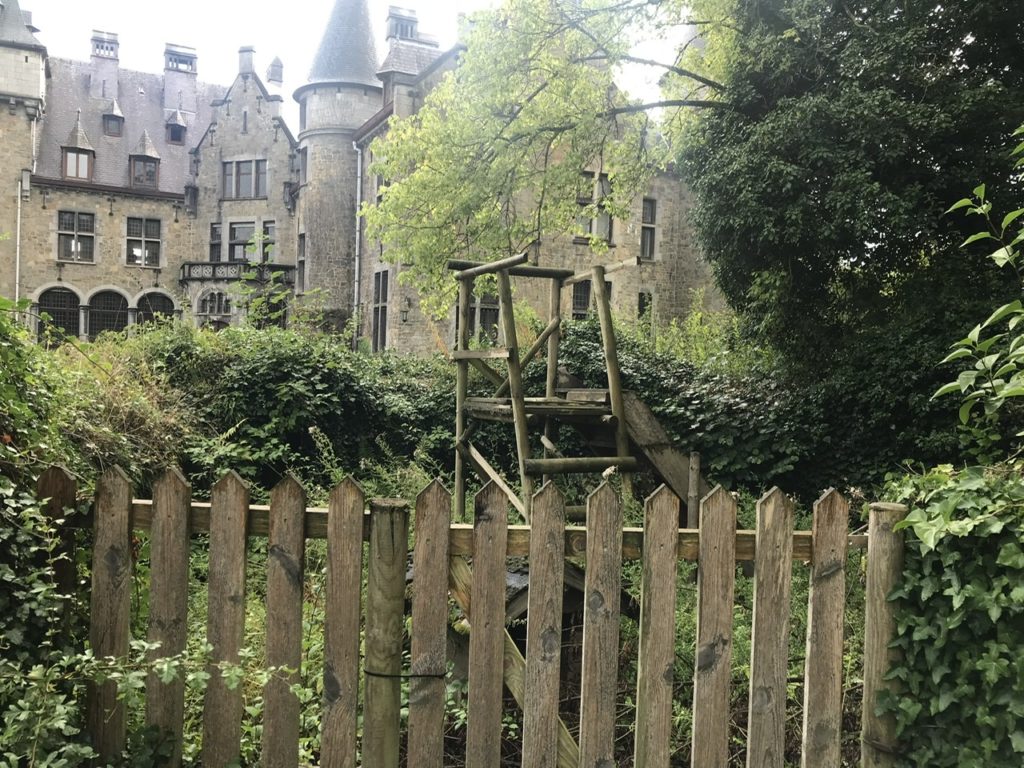
One of the great-great-great uncles of the current owner made a fortune by exporting the industrial revolution to modern-day Germany, where he was awarded a steel monopoly by the King of Bavaria. Flush with cash, the De Harenne family demolished the Chateau de Salm at the start of the 20th century and constructed the current colossal neo-medieval style chateau in its place between 1912 and 1919.
Chateau de Froidcour, Born of War
Construction was hampered by the outbreak of the First World War in 1914. According to our host, his grandfather, who owned the estate at the time, snuck across German lines to fight alongside the French and British. Meanwhile, the women and children stayed on the property.
During this period, a portion of the house was commandeered by the Germans to house POWs. Our host told us that, during a recent renovation of one of the rooms, wallpaper was removed to reveal graffiti by French soldiers. The iconic spiked Prussian helmet, or pickelhelm, was clearly visible in the drawings. Other than a bit of graffiti, the property seems to have escaped this war unscathed.
Chateau de Froidcour and the Battle of the Bulge
I’m not clear whether the De Harenne family chose a side during the Second World War, but for a brief period of time in the winter of 1944, the war came directly to their doorstep. By late 1944, the Allies had made significant gains on the Western Front and were beginning to press into Germany. On December 16, 1944, the Nazi army launched a desperate offensive campaign later known as the Battle of the Bulge. Their objective was to push through the densely forested Ardennes region and recapture the port at Antwerp. If they had been successful, they would have split the Allied lines. They were not successful.
Within a couple days, the German assault ground to a halt in the region around Chateau de Froidcour. There was substantial fighting in the nearby villages of Stoutmont and La Gleize. For a time, the Nazi commanders set up a base of operation in the castle. The ground floor was used as a field hospital while the central tower, the very place we had rented, was used to imprison American POWs. The De Harenne family was on the estate at the time. They were forced to watch as wounded soldiers succumbed to their injuries and the cold.
Eventually the Allied lines surrounded the Nazi forces that were encamped around the chateau. The Nazis were forced to abandon their equipment and retreat back towards Germany. Although our host was not born until after the war, he grew up hearing about the horrors that took place on during those few days in December.
The Chateau in Modern Times
The chateau itself may only be a hundred years old, but a lot has changed in those hundred years. A house of this size is thoroughly impractical for the modern age. In Nashville, we live in a 1500 square-foot craftsman home that was built about a decade after this chateau, and even it can be a handful to keep up. The De Harenne family has updated various portions of the estate over time, but general maintenance must cost an absolute fortune. From the ground, it’s possible to see missing windowpanes in some of the attic dormers and portions of the extensive roof that are in need of repair.
Our host is the sole owner of the property but shares its space with his siblings. Two portions of the building have been refurbished and turned into weekend apartments for the owner’s sisters, and a section of the grounds has been carved out for his brother, who built a house beside the property. They are also attempting to generate some revenue from the house. Several years ago, they refreshed the old carriage house and now rent it out via their website. The tower where we stayed was updated for the owner’s son, but now that he’s living abroad, they have begun to rent it on AirBnB. There are now plans afoot to build apartments in the other towers to generate additional rental income.
Even still, that leaves a lot of house. The majority of the building is laid out on three floors. The ground floor houses the great hall, dining room, library and study, among other rooms. These are occasionally opened to the public and were the only interior portions of the house that we visited. The family lives in a small apartment on the second floor. Meanwhile, it sounds as though the top floor and attics have been turned into storage and are rarely visited. The attached chapel sits vacant.
Our Castle Experience
Of course, time trudges on, and history is being created every day. The estate may have witnessed some epic events in the past, but the summer of 2019 held a new milestone in its history: the arrival of baby E.
Our Arrival
Our little family pulled into the Chateau de Froidcour late in the afternoon of August 14th. Unsure of what to do and feeling slightly out of place, we parked our Mini Cooper in the circular driveway and waited near the ruins of the original castle. We had seen a lot of pictures and had high expectations for the chateau. We were not disappointed.

After a few minutes, an elderly couple emerged from the house and introduced themselves as Astrid and François de Harenne. They instructed me to move the car to a new location in front of the tower for easier unloading. From there, our host guided us through the garage, past a motorcycle and 1950’s Mercedes and up the four-story stone staircase. It was quite the climb, and it took me a couple trips to get all of our stuff up. Our seventy-something-year-old host made the climb without complaint, though.
I was keen to learn more about the history of the place and happy to see that François was a talker. After about fifteen minutes, though, he excused himself, and we made plans to reunite for a longer chat the next day.
The Apartment
The apartment is large, recently renovated, clean, and blessed with excellent views. A set of binoculars are provided so that guests can look across the pastureland for foxes, deer and wild boar. In the distance you can make out a fortified medieval farmhouse.

The kitchen is fully equipped and opens out onto the living space. There is a gas stove and a gas fireplace. Our host had told us that there would be some basic provisions. It turned out that he meant milk, juice, eggs, bread, coffee, tea and chocolate…among other things.
There is only one bedroom, so we moved the chest of drawers into a hallway to make room for the travel crib. On the wall next to the crib you can still see the graffiti and names of American POWs who were imprisoned in the room in December 1944. Our host chose to keep those portions of the original wall when he renovated the tower. Beside one of the POW’s names is a handwritten letter detailing the soldier’s life after the war. Baby E was going to get a good dose of history at this place.
Exploring the Estate
The following morning, Sarah, E and I cooked up a hearty breakfast and then set out on a hike. While the De Harenne family has split off some sections of the original estate, it is still possible to go on a six-mile hike without stepping foot outside of their property. The sky was overcast and rain was forecast, but occasional gaps in the clouds let in beams of sunlight.
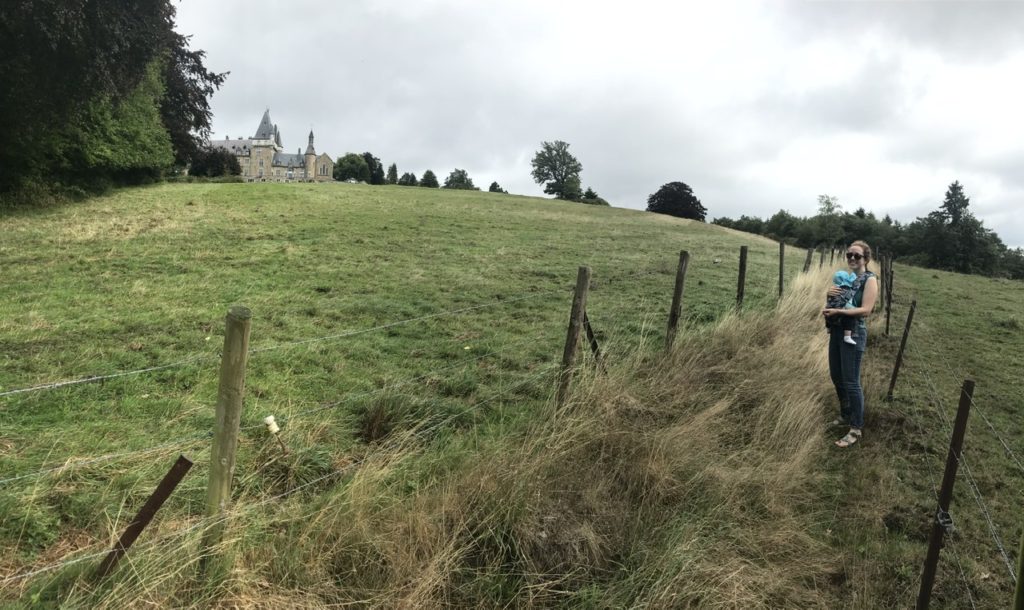
Using a map from our apartment, we made our way around the side of the castle, past the attached chapel and detached carriage house, to a large tree covered in auburn leaves. Here we found a narrow trail flanked on either side by barbed wire fencing and pastureland. Hairs, from a horse, maybe a cow, were caught on the barbs and blew in the wind. Sarah carried E across her chest. She was asleep. There were blackberries to sample along the way.
After a while, the trail entered the forest. We hiked for a couple miles along the side of ridge before making the steep descent to the riverbank. E woke up, and I took my turn carrying her. We looped back along the river. We had been nibbling blackberries as we walked, but now found ourselves surrounded by thickets of them. The sun began to cut through the clouds. Maybe it wouldn’t rain? Then the sky grew dark.


The Chateau de Froidcour’s trail loop. 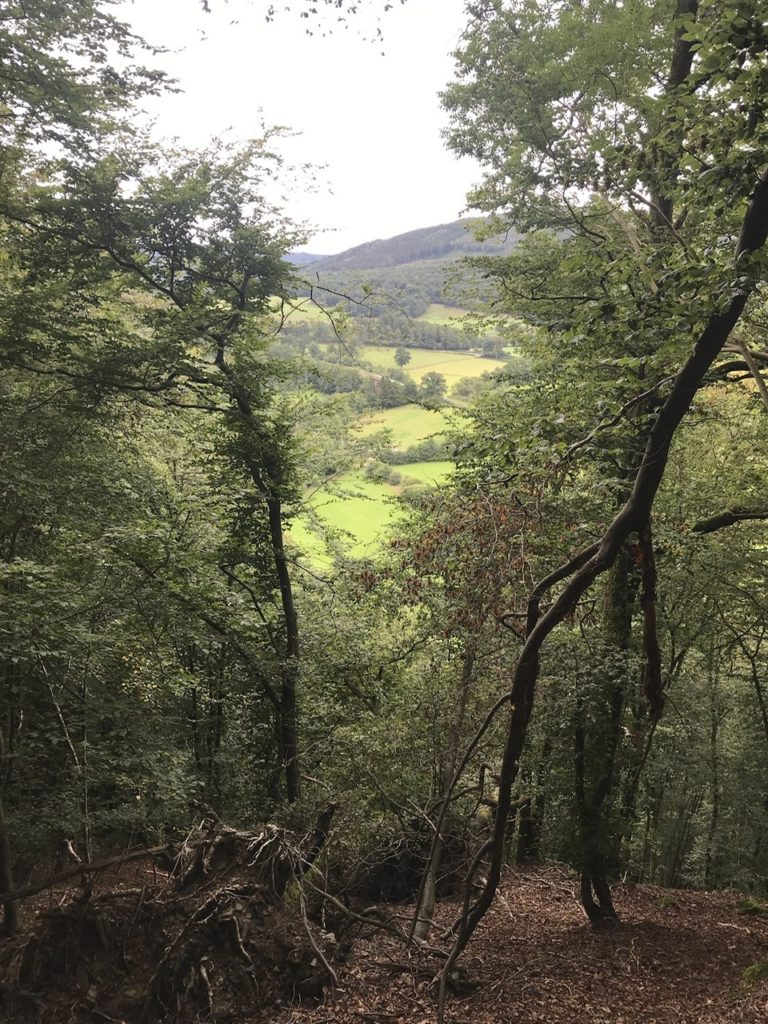
By the time we emerged from the trees, the rain was falling in a heavy mist. It was a cold, wet slog back across the pastures to the distant chateau. My shoes were soaked, but it felt great to reenter our warm apartment, turn on the gas fireplace, and settle down for some tea and chocolate.
Lunch in the Village
Traveling with a baby makes it hard to dine out in the evenings. Hence, we decided to head into the village of La Gleize after E’s second nap to get a late lunch instead. It was still pretty wet out, so we opted to drive instead of walking the three miles into town.

La Gleize is a beautiful little village of brick and stone houses. It saw a lot of action during the Battle of the Bulge and has a small museum dedicated to the subject. Otherwise, it offers a few small eateries and a very small market. Our host had highly recommended Le Vert de Pommier for a meal. We looked up the menu online and the price seemed alright, so that is where we headed. It was an excellent recommendation. The cozy old world restaurant had excellent food, and the staff seemed perfectly happy to put up with our little tag-along. We opted for a starter of farmhouse pate, followed by a kilogram of mussels and enhanced with a carafe of house wine. I’m a frugal guy, but I consider the $50 or so that we paid a great value.
After lunch we wandered around the village until the rain picked back up. It was time to get back to the castle and continue that conversation with our host.
A Visit with the Host
We returned to the tower and put E down for a nap. Our host texted to suggest that we meet in the circular drive. Would the baby monitor’s signal filter down to ground level? There was only one way to find out. Down the stairs we went. The signal dropped. Shucks. We met in the front drive and our host talked us through the history of the property, making sure to point out some of the damage that had been inflicted during the Battle of the Bulge. Then François invited us into the house.
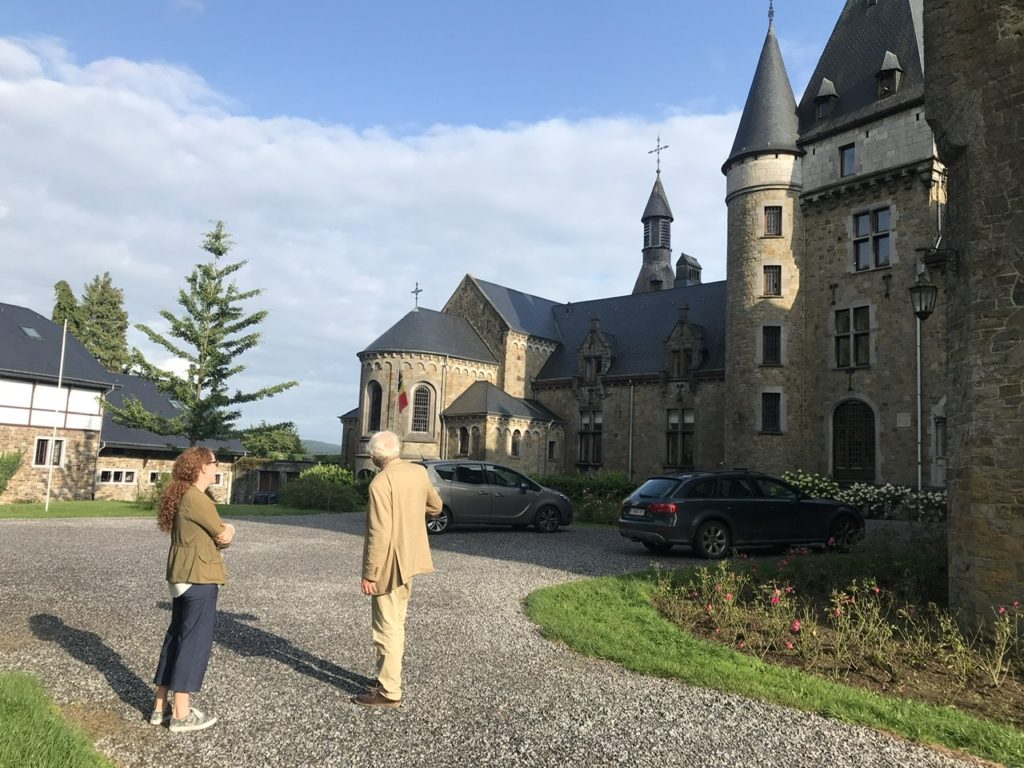
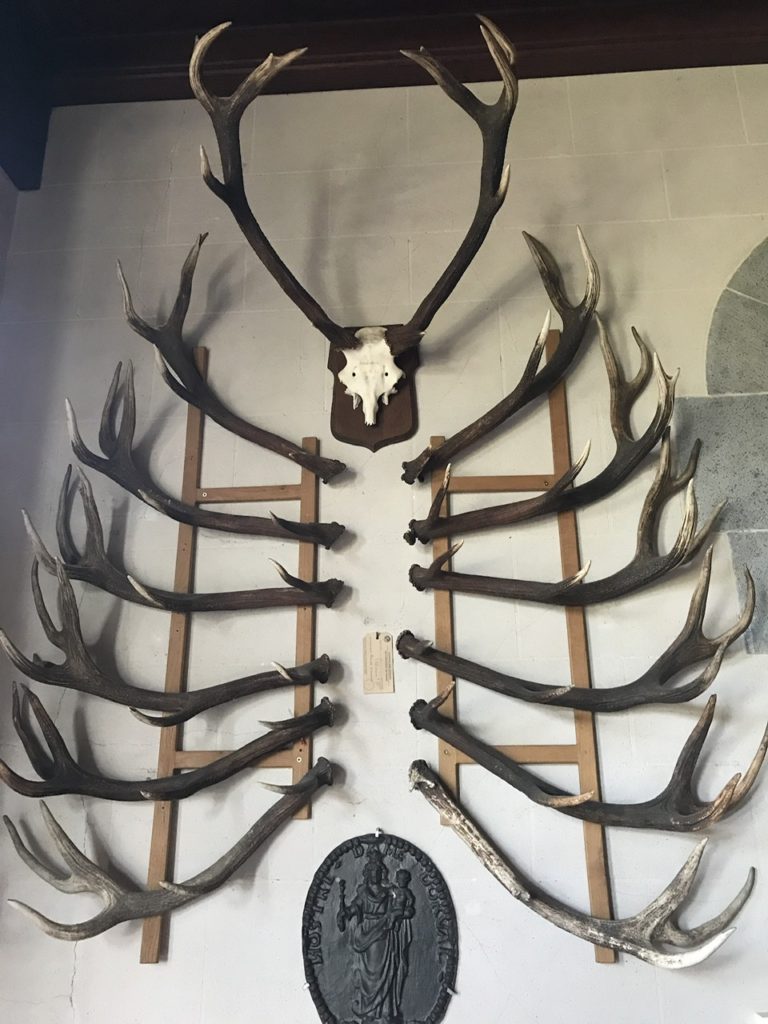
One thing quickly became clear when we stepped through the main door: the De Harenne men like to hunt. The main hall of the castle is covered in the heads and antlers of hundreds of red deer, roe deer and wild boar, some more than a hundred years old. Our host was particularly proud of a few specimens that had won medals at exhibitions in Germany during the 1930’s. While the deer heads were still in the possession of the family, most of medals were pilfered by the liberating American army.
Sarah was getting nervous about leaving E in the tower, so she went up to check on her. Our host told her to bring the baby down if she was awake. Once Sarah left, we turned our attention to a small memorial for a wild boar which his parents had raised from a piglet into a loyal and beloved family pet. The animal was put down as the German army advanced through the area at the start of World War II. That led to a discussion of all of the veterans who had paid a visit to the estate over the years.
Sarah returned with E and was told that she could use the library as a breastfeeding room if she would like. There she and E sat, surrounded by dusty books and portraits of De Harenne ancestors stretching back hundreds of years. After a time, we made our excuses and headed back up to the tower for the night.
Our Departure
We awoke the next morning, cooked another hearty breakfast, and then packed the car. We stopped for a couple of pictures on the way out and met our host’s son. He was in town visiting from Dubai. We had missed him the previous day because he had been out hunting, of course. He had bagged a large boar. It was sad to leave that morning. I think we both felt that the best part of the trip might be behind us.
In Conclusion
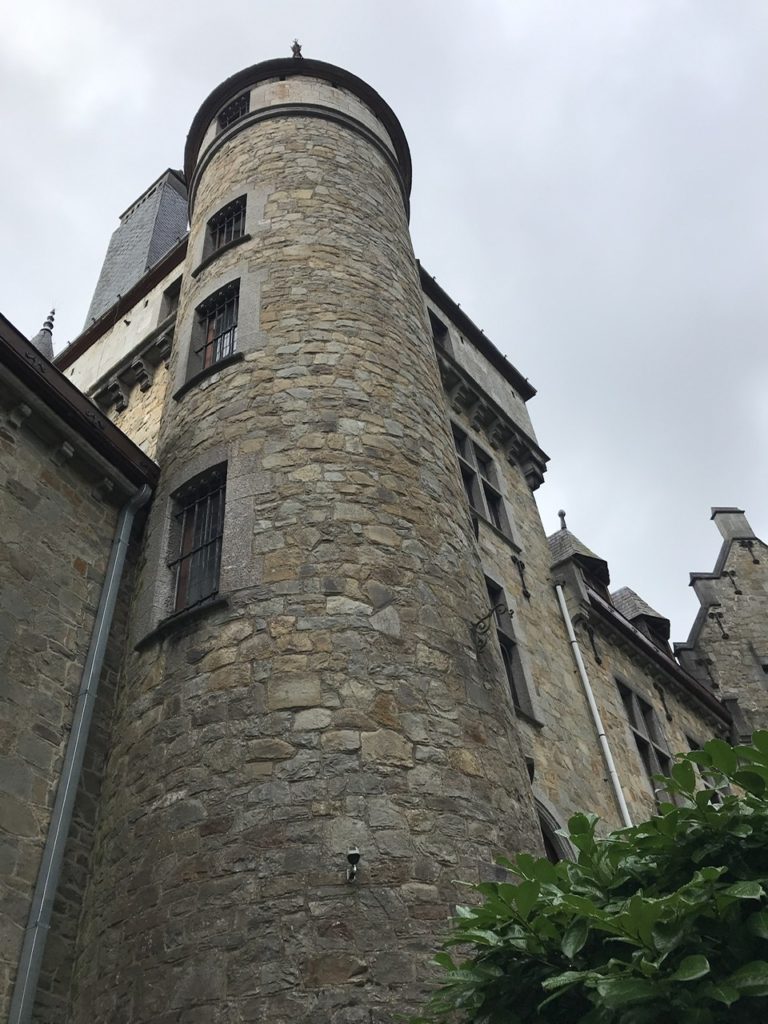
Sometimes all you need is a place to sleep, and on those occasions a cheap hotel or hostel is usually the best option. But while traveling with a baby, we’ve found that we spend an outsized portion of our trip in our rented accommodations. Sarah uses that fact to argue for renting nicer digs. I have not entirely bought into that argument, but some places really are worth the extra money.
If you are planning a trip to Europe and want to do something unique, consider booking a night or three in a castle of your own. Every good trip needs a few pre-planned highlights, and our stay at Chateau de Froidcour was certainly one of those.
As I mentioned before, we booked the apartment on AirBnB where it was called “The Falcon’s Nest” but they now have it cross listed on their own website as well.


Great read. I agree with Sarah.